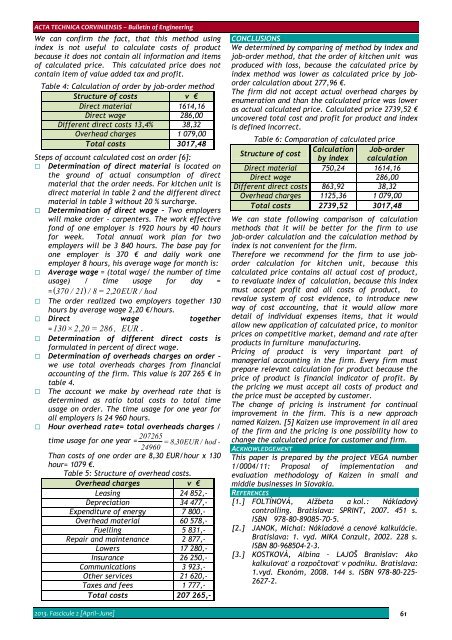a review - Acta Technica Corviniensis
a review - Acta Technica Corviniensis
a review - Acta Technica Corviniensis
Create successful ePaper yourself
Turn your PDF publications into a flip-book with our unique Google optimized e-Paper software.
ACTA TECHNICA CORVINIENSIS – Bulletin of Engineering<br />
We can confirm the fact, that this method using<br />
index is not useful to calculate costs of product<br />
because it does not contain all information and items<br />
of calculated price. This calculated price does not<br />
contain item of value added tax and profit.<br />
Table 4: Calculation of order by job-order method<br />
Structure of costs v €<br />
Direct material 1614,16<br />
Direct wage 286,00<br />
Different direct costs 13,4% 38,32<br />
Overhead charges 1 079,00<br />
Total costs 3017,48<br />
Steps of account calculated cost on order [6]:<br />
Determination of direct material is located on<br />
the ground of actual consumption of direct<br />
material that the order needs. For kitchen unit is<br />
direct material in table 2 and the different direct<br />
material in table 3 without 20 % surcharge.<br />
Determination of direct wage – Two employers<br />
will make order - carpenters. The work effective<br />
fond of one employer is 1920 hours by 40 hours<br />
for week. Total annual work plan for two<br />
employers will be 3 840 hours. The base pay for<br />
one employer is 370 € and daily work one<br />
employer 8 hours, his average wage for month is:<br />
Average wage = (total wage/ the number of time<br />
usage) / time usage for day =<br />
= ( 370 / 21) / 8 = 2,20EUR / hod<br />
The order realized two employers together 130<br />
hours by average wage 2,20 €/hours.<br />
Direct wage together<br />
<br />
= 130 × 2,20 = 286 , EUR .<br />
Determination of different direct costs is<br />
formulated in percent of direct wage.<br />
Determination of overheads charges on order –<br />
we use total overheads charges from financial<br />
accounting of the firm. This value is 207 265 € in<br />
table 4.<br />
The account we make by overhead rate that is<br />
determined as ratio total costs to total time<br />
usage on order. The time usage for one year for<br />
all employers is 24 960 hours.<br />
Hour overhead rate= total overheads charges /<br />
time usage for one year =<br />
8,30EUR / hod<br />
24960<br />
Than costs of one order are 8,30 EUR/hour x 130<br />
hour= 1079 €.<br />
Table 5: Structure of overhead costs.<br />
Overhead charges v €<br />
Leasing 24 852,-<br />
Depreciation 34 477,-<br />
Expenditure of energy 7 800,-<br />
Overhead material 60 578,-<br />
Fuelling 5 831,-<br />
Repair and maintenance 2 877,-<br />
Lowers 17 280,-<br />
Insurance 26 250,-<br />
Communications 3 923,-<br />
Other services 21 620,-<br />
Taxes and fees 1 777,-<br />
Total costs 207 265,-<br />
CONCLUSIONS<br />
We determined by comparing of method by index and<br />
job-order method, that the order of kitchen unit was<br />
produced with loss, because the calculated price by<br />
index method was lower as calculated price by joborder<br />
calculation about 277,96 €.<br />
The firm did not accept actual overhead charges by<br />
enumeration and than the calculated price was lower<br />
as actual calculated price. Calculated price 2739,52 €<br />
uncovered total cost and profit for product and index<br />
is defined incorrect.<br />
Table 6: Comparation of calculated price<br />
Structure of cost<br />
Calculation Job-order<br />
by index calculation<br />
Direct material 750,24 1614,16<br />
Direct wage 286,00<br />
Different direct costs 863,92 38,32<br />
Overhead charges 1125,36 1 079,00<br />
Total costs 2739,52 3017,48<br />
We can state following comparison of calculation<br />
methods that it will be better for the firm to use<br />
job-order calculation and the calculation method by<br />
index is not convenient for the firm.<br />
Therefore we recommend for the firm to use joborder<br />
calculation for kitchen unit, because this<br />
calculated price contains all actual cost of product,<br />
to revaluate index of calculation, because this index<br />
must accept profit and all costs of product, to<br />
revalue system of cost evidence, to introduce new<br />
way of cost accounting, that it would allow more<br />
detail of individual expenses items, that it would<br />
allow new application of calculated price, to monitor<br />
prices on competitive market, demand and rate after<br />
products in furniture manufacturing.<br />
Pricing of product is very important part of<br />
managerial accounting in the firm. Every firm must<br />
prepare relevant calculation for product because the<br />
price of product is financial indicator of profit. By<br />
the pricing we must accept all costs of product and<br />
the price must be accepted by customer.<br />
The change of pricing is instrument for continual<br />
improvement in the firm. This is a new approach<br />
named Kaizen. [5] Kaizen use improvement in all area<br />
of the firm and the pricing is one possibility how to<br />
change the calculated price for customer and firm.<br />
ACKNOWLEDGEMENT<br />
This paper is prepared by the project VEGA number<br />
1/0004/11: Proposal of implementation and<br />
evaluation methodology of Kaizen in small and<br />
middle businesses in Slovakia.<br />
REFERENCES<br />
[1.] FOLTÍNOVÁ, Alžbeta a kol.: Nákladový<br />
controlling. Bratislava: SPRINT, 2007. 451 s.<br />
ISBN 978-80-89085-70-5.<br />
[2.] JANOK, Michal: Nákladové a cenové kalkulácie.<br />
Bratislava: 1. vyd. MIKA Conzult, 2002. 228 s.<br />
ISBN 80-968504-2-3.<br />
[3.] KOSTKOVÁ, Albína – LAJOŠ Branislav: Ako<br />
kalkulovať a rozpočtovať v podniku. Bratislava:<br />
1.vyd. Ekonóm, 2008. 144 s. ISBN 978-80-225-<br />
2627-2.<br />
2013. Fascicule 2 [April–June] 61

















